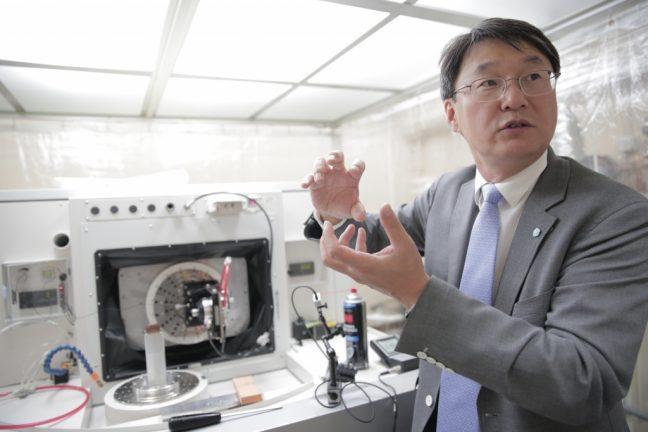The College of Engineering is now home to a machine that could represent the future of advanced manufacturing.
The first of its kind in North America, the ROBONANO α-0iB is on a multi-year loan from a Japanese manufacturer to the laboratory of University of Wisconsin mechanical engineering professor Sangkee Min.
Capable of cutting in three dimensions with nanometer precision, the ROBONANO provides Min’s laboratory with the opportunity to better understand how to cut at an ultra-precision level. They also intend to research how this advanced manufacturing method can potentially improve manufacturing for everything from toys to smart phones.
“[We want to] try to understand actually what happens during the cutting at the ultra precision level,” Min said, adding that a lot of theories at the conventional level of machining don’t work at the ultra precision level.
To begin, Min and his lab work with synthetic sapphire, a material that could be useful for tablet and smartphone screens. Lijing Yang, a mechanical engineering Ph.D. student in Min’s lab, said synthetic sapphire’s brittle nature makes it difficult to manufacture using conventional machines.
Yang came to the UW from China for her graduate studies to work with synthetic sapphire for her research project. She said the chance to work with a ROBONANO, a technology entirely new in the United States, is what initially drew her to study in Wisconsin at Min’s lab.
But Min’s lab is hoping to use the ROBONANO to tap into a more pliable version of synthetic sapphire, as it is capable of cutting about 100 times more precisely at the nanoscale than most of today’s advanced manufacturing machines.
According to Min, this is because many materials have different properties at the nanoscale, making them an entirely new type of object to work with.
Min’s team will also be researching the ROBONANO’s ability to cut emerging materials.
There are three classifications of emerging materials, Min said. The first are those synthesized in the lab. The second are materials that were not considered engineering materials because they historically have not been abundant enough, cheap enough or easily manufactured to make them a viable material for production.
The third classification, which Min is most interested in, includes materials that are currently used in manufacturing, but that could benefit from advanced technology like ROBONANO. This may give these materials a second life through more precise machining.
To illustrate this idea, Min pointed to Apple’s application of aluminum. Aluminum was already a metal used in manufacturing, but Apple transformed its use as a metal body for computers — something that had never been done before. Before, computer bodies had always been made through injection molding, so other computer manufacturers built computer bodies from plastic.
By using the ROBONANO to study properties of synthetic sapphire and emerging materials, Min hopes the use of existing materials can be expanded into other industries, similarly to Apple’s innovative use of aluminum in an industry where only plastic had been used before.
“If some of the other manufacturing processes can create the same kind of the features that the other industries can generate right now, and with a different process which can handle different types of materials, then that opens up new opportunities,” Min said. “Something that wasn’t possible becomes possible.”


